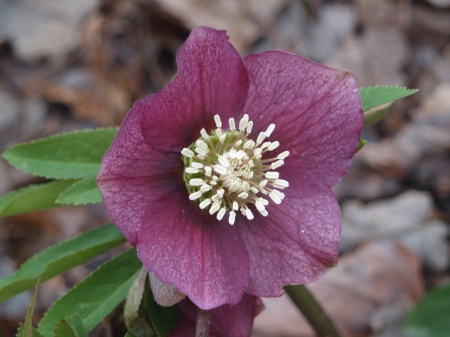Prompt action in the early morning prevented all but minor damage to Japanese maples and evergreens that were bent from the heavy, wet snow a few days ago. Of course, I happily crow my successes (few as they are), and remain largely silent when schemes go awry. The garden has suffered considerably from heavy snow in recent years, so I’m pleased that only a bit of minor pruning will be required to shape up the magnolias and crapemyrtles injured in this recent storm.
Snow often lingers in this shaded garden for days after it has melted from neighboring properties, and even with warm, sunny afternoons much of the garden bordering the tall tulip poplars and maples remained covered until today. The hellebores (Helleborus x hybridus, above) emerged from the snow unscathed, and now they are at their peak bloom, though they will begin to decline with warmer days over the next few weeks. Already, dozens of seedlings are seen sprouting close to the largest clumps. These will be left until they are well rooted, then many will be transplanted to other partially shaded spots.
Leatherleaf mahonias (Mahonia bealei, above) are flowering in their typical period, though this is many weeks later than last year when they bloomed early in our extraordinarily warm January. I have planted several of these mahonias that slowly spread from the roots, but several others have sprouted from seed deposited by birds who consumed the grape like fruits. Thus, leatherleaf mahonia is considered invasive in some regions, though I have not seen any areas where it has spread sufficiently to threaten native flora.
If this is a concern I recommend the hybrid, early winter flowering Mahonia ‘Winter Sun’, which has similar yellow flower panicles, and a more compact form than leatherleaf mahonia. I read recently that a native plant group recommends substituting the native deciduous holly (Ilex verticillata) and American holly (Ilex opaca) for leatherleaf mahonia, but these are plants with wildly dissimilar habits. These natives are superb plants when used properly, but only a gardener demanding exclusively native plants without a care for their growth characteristics would consider these as suitable alternatives for the evergreen and smaller growing mahonia. In my experience I haven’t seen evidence to consider leatherleaf mahonia an invasive threat in the mid-Atlantic region, though occasional seedlings must be weeded out.
Sweetbox (Sarcococca humilis, above) is flowering, though the blooms are small enough that they are barely seen. The gardener is often alerted to their flowers by the potent fragrance, but with my poor sense of smell I can smell them only occasionally. In any case, the foliage is pleasantly glossy, and after taking a few years to get started sweetbox creeps steadily along, spreading from the roots.
This spring is a little slow getting started, and even with a few warm, sunny days the buds of the early flowering magnolias show no signs of opening. The edgeworthias are also late in blooming, showing little change since early in February. But, these will come soon enough, and after several weeks of cold, then nearly foot of snow, it appears that spring has nearly arrived.
Spring is slow to come here as well, though it is persistent. Daffodils are well up, the weeping willow in the backyard is leafing out, trees are starting to blossom. The temps are certainly on the rise, though it wasn’t a particularly cold winter here so they didn’t have far to creep before becoming downright pleasant. Still, I’m ready for Spring and the wonderful chartreuse of new leaves on the trees! Though NOT for the pine pollen…
My particular allergy is maple pollen which typically arrives by mid March. For most of my life I had no recognizable allergies, but this crept up in recent years. I don’t relish the thought, but since it arrives at the same time as spring I’m happy to suffer through.
What a thrill to see some bloom action outside after the winter siege. My hellebores are going strong and hope to purchase sweet box this year. After years of admiring a gorgeous jasminum nudiforum on Lee Street in Warrenton I finally acquired a plant last fall. Alas, the discriminating gourmet deer here keep it to ground level and I’m off to Lowes for something to enclose it. May not ever succeed in getting blooms but I’ve got to give at my best effort. Anything that bllooms early is such high value!
I’ve not had a problem with deer and my winter jasmine. Of course, the jasmine tumbles over boulders at the edge of a large pond, so it is treacherous for me to get close enough to enjoy the winter blooms. Later in the week I’ll address the two great scourges of my garden, squirrels and deer, and the steps I’ve take to minimize these problems. I’ve been very successful in discouraging deer by regularly spraying a repellent, and you’ll be able to read the story in a few days.